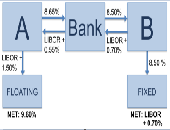Recent reforms to the swaps market can be thought of as “the futurization of swaps,” said Nathan Jenner, COO Fixed Income E-Trading at Bloomberg. He was addressing a webinar audience on May 14, 2013 as the first speaker in a panel organized by the Global Association of Risk Professionals (GARP) on the evolution of the market for over-the-counter (OTC) swaps.
Five years ago, “derivatives were perceived as a catalyst in precipitating” the financial crisis of 2007-08, said Jenner. For example, it wasn’t immediately apparent who were all the counterparties to the AIG swaps. Pricing was “murky,” he said, and risk was systematically interlinked.
Dodd-Frank regulations enacted after the crisis aim to increase pricing transparency and mitigate the systemic risk. Jenner outlined three tools to promote transparency:
(1) Swap data reporting (SDR) that was effectively a ticker-tape of what traded and at what price (“post trade information”). Jenner said analysts can type in “SDR” to Bloomberg terminals and see a live feed of such information;
(2) swap execution facilities (SEF) that may be viewed as essentially “pre-trade” information; and
(3) business conduct rules via the US Commodity Futures Trading Commission (CFTC).
There are a series of three deadlines at which certain segments of the market will convert to central counterparty clearing (CCP) as mandated by the Dodd-Frank Act in order to address the systemic risk problem.
(a) March 11, 2013 – Category 1 – This covers entities such as swap dealers, major swap participants, and active funds
(b) June 10, 2013 – Category 2 – This covers commodity pools, hedge funds, and nonswap dealer banks so long as the entity is not a third-party subaccount
(c) September 9, 2013 – Category 3 – This covers all non-commercial end users such as pension funds will be clearing through the CCP by this date.
Jenner elaborated on why he described the evolution of the OTC swaps market as a “futurization.” Currently there are several products such as CME, ICE, and Eris whose main difference lies in their margin regimes; these can range from 2 days to 5 days.
There is a standardization of swaps product that is underway, according to Jenner. He likened it to the “big bang” in the credit default swaps (CDS) market that occurred with a change in regulations. Standardization means market participants must come to agreement on coupons and dates.
“These forces—standardization versus the need to customize—are constantly tugging at each other,” said Jenner. The market needs to allow full customization. He cited examples: A customer may need to tailor the OTC swap for the date when it becomes effective, or the date when it ends. There may be differing notional amount each year.
On May 16, 2013, the CFTC will meet to discuss electronic execution of swaps. “One thing nobody argues about is that there’s been a tremendous growth in electronic trading. [The customer can get] great liquidity and great pricing… [so] they gravitate toward electronic trading.” Now is a time of significant growth of SEFs, compared to two years ago, Jenner added.
There will be more impacts to the market. In the next 6 to 24 months, the industry will begin a “huge undertaking” to create smooth direct loading of SEF data for all CCPs.
Infrastructure and technology solutions must be carefully reviewed, advised Jenner, and customers should consider carefully which clearing broker they plan to partner with. ª
Go to Part 2. ª
The webinar presentation slides can be found at: http://event.on24.com/r.htm?e=611755&s=1&k=6ABEF3C03DCBA765B805478C9C9B672E>
Bill Hodgson provides a blow-by-blow summary of the OTC updates on The OTC Space at: http://theotcspace.com/2013/01/08/latest-ccp-sdr-status-charts/


